Green Tea: Everything You Need To Know
Did you know that green tea is one of the healthiest drinks on the planet? It’s true! Green tea is loaded with antioxidants and nutrients that can benefit your body in a myriad of ways. There are so many benefits to drinking green tea that it might just be time to start making it a part of your daily routine. Keep reading to learn all about green tea, its many benefits, and how to make the most out of this amazing drink.

What Green Tea Is
Green tea is made from the leaves of the Camellia sinensis plant, the same plant used to make black and oolong teas. However, what sets green tea apart is its processing method. The leaves are lightly steamed or heated immediately after being picked, preserving their green color and preventing oxidation. This differs from black tea, which undergoes a fermentation process that gives it its deep brown color and bold flavor profile. Green tea also has a lower caffeine content than black tea, averaging around 35 mg per cup compared to 40-60 mg for black tea.
In addition to its unique flavor characteristics, green tea is also prized for its potential health benefits due to high levels of antioxidants called catechins. Many studies have linked regular consumption of green tea to a reduced risk of cardiovascular disease and some forms of cancer. No matter how you enjoy it – hot or iced, plain or with added flavors – green tea can be a delicious addition to anyone’s daily routine.

There are countless reasons why you should add green tea to your diet. Here are seven impressive benefits.

1Green Tea Boosts Brain Function
Green tea has long been touted for its numerous health benefits, and now, we can add improved brain function to the list. The key player in green tea is its high concentration of catechins, especially a type called EGCG. Numerous studies have shown that EGCGs can enhance cognitive function, including memory and attention.
One study even found that individuals who drank green tea performed better on cognitively challenging tasks compared to those who did not consume green tea. In addition to EGCGs, green tea also contains caffeine and the amino acid L-theanine, both of which have been shown to improve brain function. So the next time you’re looking for a pick-me-up or an aid for studying or focusing at work, look no further than a cup of green tea.

2Green Tea Increases Fat Burning
Have you ever tried incorporating green tea into your weight loss routine? Recent studies have shown that green tea not only helps boost metabolism but also increases the rate at which the body burns fat. How does this work exactly? The active ingredient in green tea, called EGCG, inhibits an enzyme responsible for breaking down norepinephrine, a hormone that signals the body to burn fat.
In other words, EGCG helps norepinephrine stay active longer, leading to increased fat burning. It’s important to note that while green tea can contribute to weight loss efforts, it shouldn’t be relied upon as a sole source of weight loss. Combining green tea with healthy eating and exercise habits is key to achieving successful results. So why not give it a try? Brew yourself a cup of green tea and watch as it helps you on your journey toward reaching your weight loss goals.

3Helps Lower Your Risk Of Cancer
The health benefits of green tea have been widely studied, and one exciting discovery is its potential to lower the risk of cancer. How does it work? Green tea contains polyphenols, which have been shown to reduce inflammation and cell damage that can lead to tumor growth.
One study found that individuals who drank green tea had a 48% lower risk of lung cancer, while another study revealed a 56% decreased risk of colorectal cancer in those who regularly consumed green tea. It’s essential to note that green tea should not be considered a cure or replacement for cancer treatment, but incorporating it into your diet may offer additional protection against the disease. To maximize the potential health benefits, opt for brewed green tea rather than bottled varieties, which may contain added sugar and artificial ingredients.

4Helps Lower Your Risk Of Type II Diabetes
Numerous studies have shown that regular consumption of green tea can lower the risk of developing Type II diabetes. One study, published in the Journal of Nutrition, followed over 40,000 Japanese adults for 11 years. It was found that those who drank the most green tea had a 42% lower risk of developing diabetes than those who drank the least.
So how does it work? Green tea contains polyphenols, powerful antioxidants that help regulate blood sugar levels and improve insulin sensitivity. So not only can drinking green tea help prevent the onset of diabetes, but it can also be a beneficial addition to an existing treatment plan for diabetes.
Keep in mind that adding sugar or milk to your green tea can negate some of its health benefits, so opt for unsweetened and try using honey as a natural sweetener instead. Also, remember that green tea should not be used as a substitute for medication or other medical treatments; always consult your healthcare provider before making any changes to your diabetes management plan. But if you are looking for small lifestyle changes with a big impact, sipping on some green tea each day just might be worth a try.

5Protects From Neurodegenerative Diseases
When it comes to protecting the health of our brains, green tea may be a valuable ally. This ancient beverage contains compounds called catechins, which have been shown to inhibit the buildup of toxic proteins in the brain that can lead to neurodegenerative diseases, such as Alzheimer’s and Parkinson’s. However, it’s vital to note that these benefits are only seen with regular consumption – simply drinking a cup here and there will not provide enough catechins to make a difference. So for those looking to protect their brain health, make green tea a daily habit. It’s an easy addition to your routine with delicious potential benefits.

6Lowers The Risk Of Cardiovascular Disease
Green tea has long been associated with health benefits, and recent studies have shown that it can have a positive impact on cardiovascular health. One compound, in particular, epigallocatechin gallate (EGCG), has been shown to lower levels of bad cholesterol and improve the function of arteries. A meta-analysis of multiple studies found that those who drank green tea regularly had a lower risk of developing cardiovascular disease than those who did not. However, it’s important to note that the benefits are most significant when consumed as part of a balanced diet and healthy lifestyle. Still, incorporating green tea into your daily routine can be an easy way to support your heart health.

7Green Tea Can Improve Dental Health
Did you know that green tea can have a positive impact on your dental health? Studies have shown that drinking green tea could potentially reduce the presence of harmful bacteria in the mouth, improving gum health and reducing bad breath. In addition, the regular consumption of green tea has been associated with a lower risk of cavities and tooth loss.
How exactly does green tea accomplish this feat? The secret lies in its high catechin content, a type of antioxidant known for its anti-inflammatory and antimicrobial properties. So the next time you reach for a cup of tea, consider choosing a green variety for its potential oral health benefits. Just be sure to let it cool before sipping, as consuming beverages that are too hot can also harm tooth enamel.

Green Tea Can Improve Dental Health
From the most popular green tea blend in the west, sencha, to the scarce and prized gyokuro, there are many varieties of green tea to explore. Matcha (typically a bright shade of green) is made from powdered young tea leaves and is used as an ingredient in traditional Japanese tea ceremonies. Genmaicha combines green tea with roasted brown rice for a unique nutty flavor. Hojicha is typically served after meals in Japan due to its lower caffeine content and is made from roasted green tea leaves for a rich, toasty taste. Dragonwell or Longjing is one of the most famous Chinese green teas and features flat, sword-shaped leaves with a delicate, slightly sweet flavor; when it comes to types of green tea, there’s truly something for every palate.
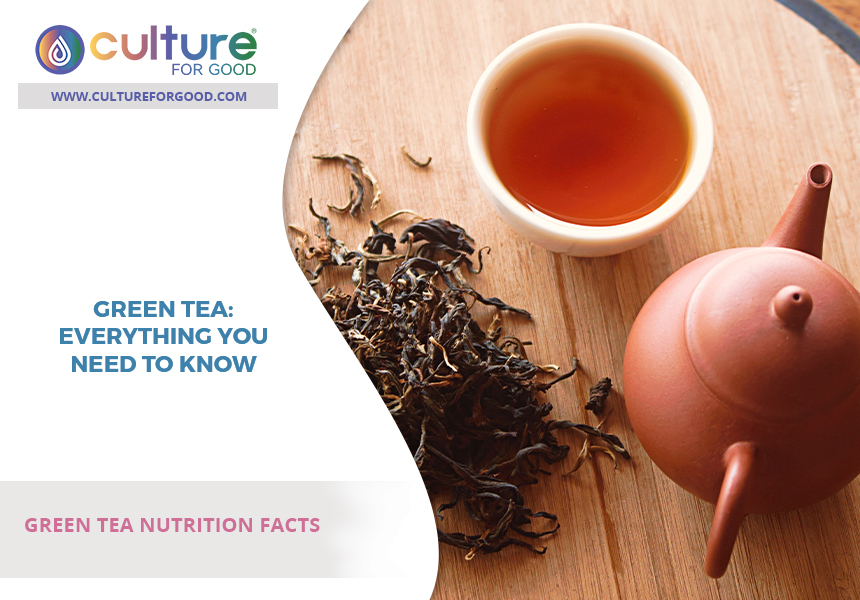
Green Tea Nutrition Facts
Drinking green tea has been a staple in various cultures for centuries, and now, modern science is confirming many of its reported health benefits. One cup of green tea contains only two calories and zero grams of fat, making it a great addition to any weight loss or maintenance plan. It also provides a small number of essential nutrients, including folate, manganese, and potassium.
Green tea is particularly high in antioxidants – compounds that fight cell damage and may reduce the risk of chronic diseases, such as cancer. One cup of green tea provides roughly ten to forty percent of the recommended daily intake for key antioxidants, like catechins and epigallocatechin gallate. Overall, incorporating green tea into one’s diet can provide both delicious flavor and vital health benefits.
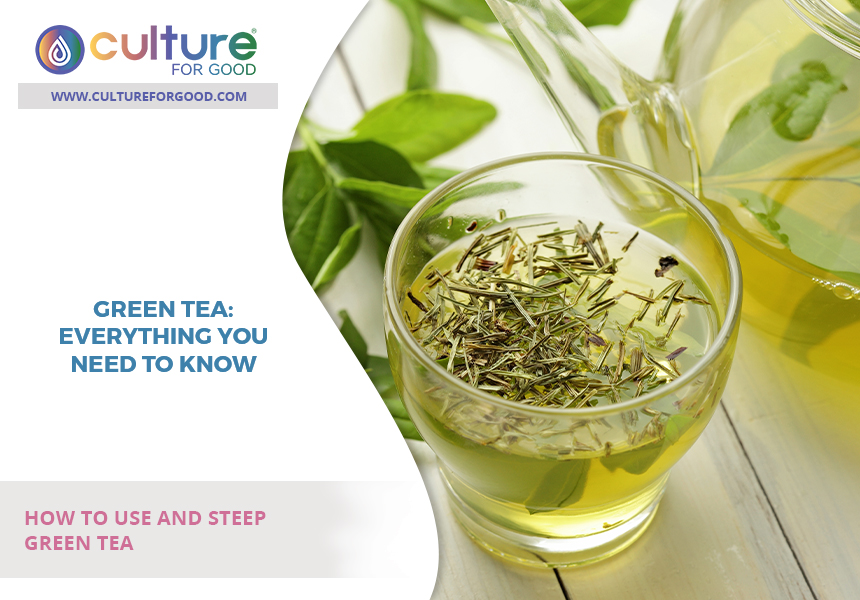
How To Use And Steep Green Tea
Green tea is a popular choice for many tea drinkers, thanks to its health benefits and tasty flavor. Steeping green tea properly can enhance its taste and maximize its potential health benefits. To start, make sure to use water that has been heated to just before boiling (around 175-185 degrees Fahrenheit). Let the water cool for about one minute before pouring over the tea leaves.
For loose-leaf tea, use about one teaspoon of leaves per cup of water. For teabags, steep just one bag per cup of water. Allow the tea to steep for two to three minutes before removing the leaves or teabag and enjoying your cup of green tea. To enhance the flavor, try experimenting with steeping times or adding other ingredients like lemon or honey. Happy sipping!
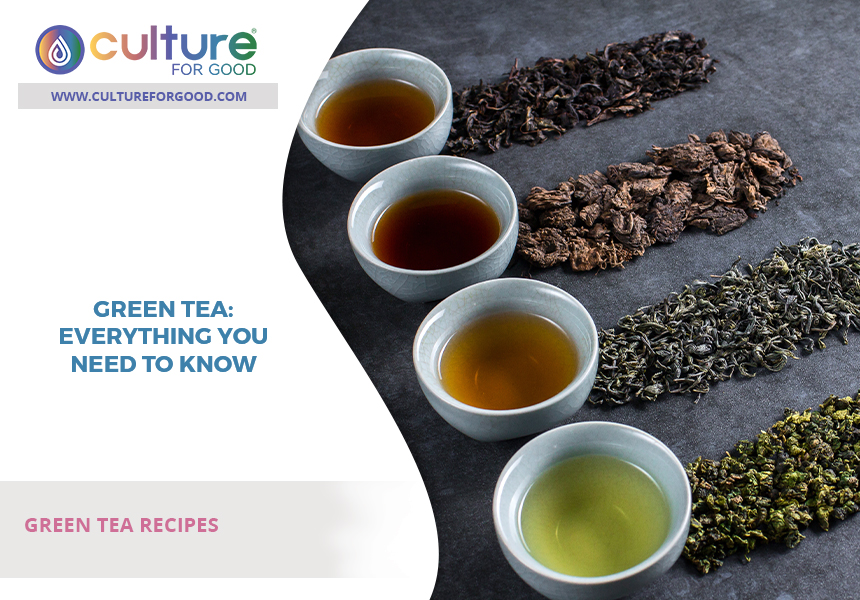
Green Tea Recipes
If you’re looking to add a new twist to your daily cup of green tea, try adding some fresh ingredients to the mix. For a refreshing drink, try mixing in sliced cucumber or mint leaves. For a more indulgent treat, stir in some honey or agave and top with whipped cream. You can also incorporate green tea into your cooking by using it as a marinade for meats, such as chicken or fish, or even mixing it into desserts, like ice cream or cheesecake.
Don’t be afraid to experiment with different flavors and ingredients – the possibilities are endless with green tea recipes! Just remember to steep your green tea properly and use high-quality leaves for the best taste. Happy experimenting! Here are three green tea recipes to try.

BREAKFAST: Green Tea Smoothie
Ingredients:
1 banana
1 cup spinach
1 cup green tea, cooled
Directions:
Blend all ingredients in a blender until smooth. Enjoy as is or pour into a glass and enjoy!

LUNCH: Green Tea Quiche
Ingredients:
1 pie crust (homemade or store-bought)
4 eggs
1/2 cup milk
1/2 cup green tea, cooled
1/2 onion, diced
2 cloves garlic, minced
1/4 teaspoon salt
1/4 teaspoon black pepper
1/2 cup shredded cheddar cheese
3 green onions, thinly sliced
Directions: Preheat oven to 375 degrees Fahrenheit; layer the pie crust in a nine-inch pie dish. In a large bowl, whisk together eggs, milk, and green tea; add onion, garlic, salt, and pepper. Pour the mixture into the pie crust; sprinkle with cheddar cheese and top with green onion slices. Bake for 25-30 minutes or until quiche is golden brown and set; let it cool for five to ten minutes before serving. Enjoy!

DINNER: Green Tea Salmon
Ingredients:
4 salmon fillets
1/4 teaspoon salt
1/4 teaspoon black pepper
2 tablespoons olive oil, divided
1/2 cup green tea, cooled
1/4 cup honey
3 cloves garlic, minced
1 lemon, juiced
Directions: Preheat oven to 400 degrees Fahrenheit; season salmon fillets with salt and pepper. Heat one tablespoon of oil in a large skillet over medium-high heat; add salmon and cook for two to three minutes per side or until browned. Remove from the skillet and place on a baking sheet lined with foil; in a small bowl, whisk together green tea, honey, garlic, and lemon juice. Drizzle over salmon; bake for ten to twelve minutes or until salmon is cooked through. Enjoy!

History Of Green Tea
The history of green tea dates back to ancient China, where it was first used as a medicinal drink. It eventually became a popular beverage among the elite, with emperors and nobility including it in their daily rituals. In the eighth century, Japanese monks brought green tea plants back from China and developed their unique method of production.
It quickly gained popularity in Japan as well, with the practice of ceremonially preparing and serving tea becoming an essential part of their culture. In the 1700s, green tea was introduced to Europe and eventually spread to other parts of the world. Today, it remains a popular beverage with numerous health benefits, thanks to its high concentration of antioxidants. From its humble beginnings as a medicinal drink in ancient China to its modern place as a globally enjoyed beverage, green tea has certainly made its mark on history.
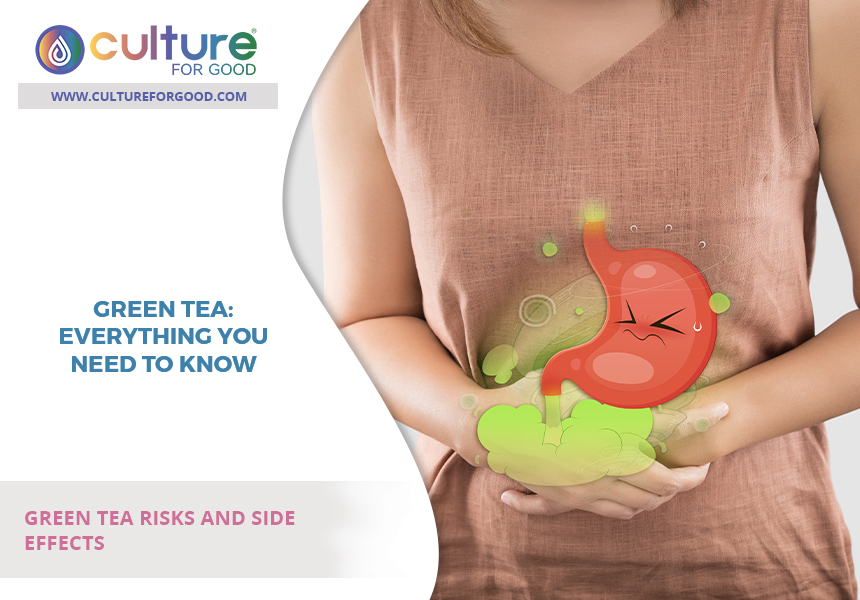
Green Tea Risks And Side Effects
While green tea has been praised for its various health benefits, it is crucial to note that there are potential risks and side effects associated with its consumption. These can include stomach irritation, headaches, and constipation. Green tea also contains caffeine, which can lead to insomnia, anxiety, and irregular heartbeats if consumed in excessive amounts.
Additionally, green tea can interact with certain medications, such as blood thinners and antidepressants. It is crucial to consult with a healthcare professional before consuming green tea or combining it with any medication. Pregnant women should limit their green tea intake, as it may affect fetal development. Despite these potential risks and side effects, many experts agree that moderate green tea consumption can still offer benefits for overall health and wellness. It is all about finding the right balance for your individual needs.
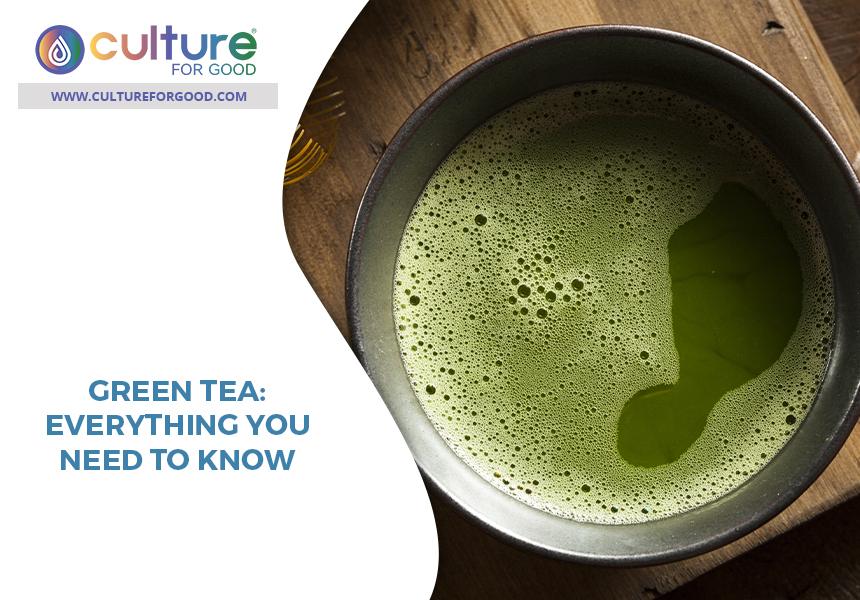
Taking time to understand what your body needs to be healthy is one of the most vital things you can do. Green tea can be a delicious and healthy part of your diet, but it is crucial to remember that moderation is key. Listen to your body and consult a healthcare professional if you have any concerns. Now that you know everything there is to know about green tea, go ahead and enjoy a cup!





















